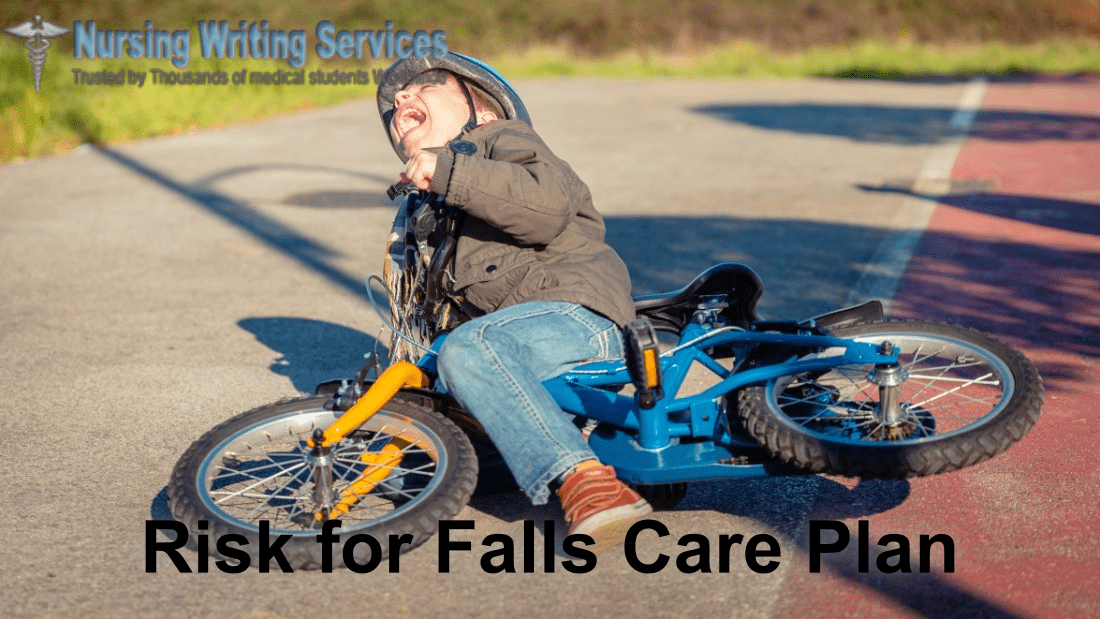
The risk of falls is an increase in susceptibility to falling. Decreased function and failing health are the frequent cause of fall-related accidents, which put victims at the risk of fractures and other serious injuries. Once the likely existence of Risk of fall is diagnosed, Risk for Falls Care Plan is key in the effort of handling this condition.Risk for Falls Care Plan Writing Services helps students and nursing professionals to get an up to standard and effective Risk for Falls Care Plan they need. Writing a Risk for Falls Care Plan requires dedication because one needs to know what to write, how and where to write it. This calls for a specialized Risk for Falls Care Plan Writing Services from a top company like Nursing Writing Services.
The risk for Falls Diagnosis
Since falling is not a disease, it has no symptoms. Nevertheless, there are ways we can prevent falls. While the prevention measures may involve being careful with places one visits or walks on, the fact that most falls are accidental means that we can only try to reduce the risk of falls. A caregiver can only rely on the risk factors by conducting a falls risk assessment. When an individual is taken to a nursing home after a fall, the nurse caring for the patient should observe the patients’ health condition and lifestyle to determine the best nursing care plan that will prevent more falls.
Here are some of the common risk factors for falls:
- Muscle weakness in the legs
- Balance difficulties
- Dizziness (Vertigo)
- Sensory disorders such as ear and eye problems
- Numbness in the feet and legs
- Brain disorder or mood swings including dementia
- Psychotic behavior
- Depression
- Delirium
- Alzheimer's or Parkinson's disease
- Arthritis
- Chronic pain
- Dehydration
- Low vitamin D levels
The risk for Falls Care Plan Goals and Outcomes
Anyone nursing a person with the above risk factors should define ways of promoting safety behavior to prevent falls and any risk of injury. A nursing care plan for patients susceptible to falls should enable them to control risks as evidenced by these indicators:
- Cooperate with a caregiver to implement strategies for increasing safety and preventing falls at home
- Relate intent to use safety measures for preventing falls
- Demonstrate selective prevention measures
- Engage in daily activities without falling
- The risk for Falls Care Plan
The risk for Falls Care Plan Assessment and Rationales
The risk for falls is due to several factors. A holistic assessment approach should be part of the care plan to help the caregiver in obtaining a detailed analysis of the fall risk factors. It is necessary to perform this assessment and distinguish the main risk factors specific to an individual patient by checking at these factors.
History of falls: An individual who has fallen once or more times in the last six months is more likely to fall again.
Change in mental status: Inability to make decision and confusion increase chances of falling. Some of the nursing interventions to reduce falls in such people include taking close care of them and putting them in places they are less likely to fall.
Physical changes of aging: Older people are likely to fall primarily if they have weak muscles. Other age-related changes that increase the risk of falls are reduced the visual ability, unsteady gait, impaired color perception, impaired balance, and delay in response and reaction.
Sensory deficits: Impairment of hearing and vision limits the ability of the patient to notice hazards in the surroundings are also some of the causes of the fall in most people. Mobility assistive devices: Inappropriate use and lack of maintenance of these devices may increase the risk of falls in patients.
Diseases and medications: People with symptoms of untreated diseases such as reduced cerebral blood flow or orthostatic hypotension or fatigue make the patient feel weak and increase the risk of falls. Medication drugs affect the level of consciousness and BP thus increasing the risk of a fall. Therefore, nurses should assess the patients for such symptoms and provide a nursing diagnosis that will lead to a long-term solution.
Unsafe clothing: A patient more so the elderly is at higher of falling for wearing long robes or pant legs that trap the feet or ill-fitting shoes that affect balance and gait.
The risk for Falls Care Plan Interventions and Rationales
Personal and collaborative interventions as part of the nursing care plan to patients with risk of falls help to reduce the danger. Work With Healthcare Specialists to Access Possible Causes Of Regular Falls A review of a patient's health and prescription by a specialist helps to determine the side effects of the medicine and other significant risk factors. For example, physical therapy evaluation can identify any balance and gait problems. Treating the identified problems or changing the medication that affects a patient can reduce falls.
Place Essential Items within Easy Reach
Placing items where the patient can reach them without struggling reduces the hazard of falls. Place beds in the lowest possible position. Keeping a bed or modifying the sleeping surface new the surface reduces the chance of fall and serious injuries. Use of rails on beds also increases safety for confused or disoriented patients. Nursing assessments are essential in determining how to position a patient, as you would be able to know what they can or cannot do.
Familiarize the Patient with the Room, Building, and Compound Layout
Familiarity with the surroundings prevents the risk of tripping. When a patient is aware of his or her surrounding, he or she will find it easy to navigate the place without any risks of falling. Once you familiarize the patient with an area, you should not make abrupt changes within the room as it may cause fatal falls.
Provide the Patient with Heavy, Firm, and Secure Furniture
Heavy and secured furniture will not tip over when the patient sits or lies on it. Such furniture also provides a point for the patient to hold on to support when walking.
Encourage Use Wearing Non-Skid Shoes or Slippers
Footwear provides better grip for persons with diminishing foot and toe lift; thus, it ought to be part of the risk for falls interventions that nurses should consider. In homecare situations, a caregiver should think, with the help of the family, about ways of improving safety in the patient’s space such as adding handrails in bathroom or wall. A nurse should also encourage the revision of adequate lighting, use of eyeglasses and hearing aids. It is also imperative that the nurses or caregivers observe the nursing care plan risk for falls example that has been applied elsewhere.
Our Risk for Falls Care Plan Writing Services stands out because it has been in the profession and the writing industry for a long time. Our writers have vast experience in the writing profession working with different groups of nurses and students backed with training in medical and nursing sciences. This makes Nursing Writing Services deliver the best Risk for Falls Care Plan Writing Services aimed for your smooth operations or academic success. Our clients have many reasons to work with us among them us being a leading Risk for Falls Care Plan Writing Services provider. Therefore, we to make sure that stands by delivering quality Care Plans.
- Nursing Care Plans Writing Services
- Nursing Care Plans in APA Writing Help
- Best Nursing Care Plan Writers



